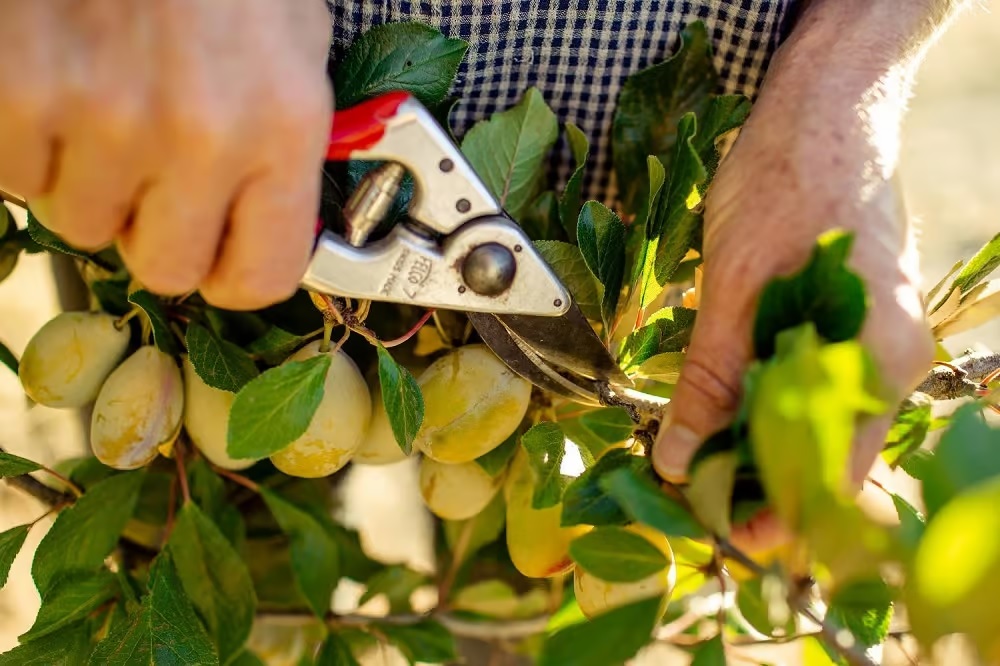Pruning plum trees is essential to maintain their health, shape, and productivity. Unlike apples or pears, plums require specific pruning techniques to avoid issues like silver leaf disease and to promote abundant harvests. This article outlines seven practical strategies to prune plum trees effectively, ensuring gardeners of all levels can achieve success. A specialist from ChrisBowers, a trusted nursery, advises: “Proper pruning enhances fruit quality and tree vigour. For optimal results, focus on summer pruning to reduce disease risk and explore our range of plum trees to find varieties suited to your garden.” These quick wins provide clear, actionable steps to improve your plum tree’s performance.
The Best Time to Prune
Timing is critical when pruning plum trees. Unlike pome fruits such as apples and pears, which are typically pruned in winter, plums are best pruned in late spring or summer, ideally from mid-June to early August. This timing reduces the risk of silver leaf disease, a fungal infection that enters through pruning cuts during damp, cold months. The fungus, which affects the Prunus family including plums, cherries, and apricots, can cause silvering leaves and branch dieback. By pruning in warmer months, wounds heal faster, minimising infection risk. For young trees, spring pruning when buds are bursting is ideal, while established trees benefit from mid-summer cuts. This approach ensures the tree remains healthy and productive, setting the stage for the other pruning strategies.
Focus on Creating an Open Centre Shape
One of the most effective ways to prune plum trees is to shape them into an open centre, often described as a goblet or wine glass form. This structure allows sunlight and air to penetrate the canopy, promoting fruit ripening and reducing disease. To achieve this, begin with young trees by selecting three to five main branches radiating from a short trunk, typically 75cm to 1.5m tall, depending on whether you’re training a bush or half-standard tree. Remove any shoots growing into the centre to prevent congestion. For established trees, cut back branches by about a third in summer, focusing on removing crossing or inward-growing shoots. This shape not only enhances fruit quality but also makes harvesting easier, as fruits are more accessible. Gardeners looking to start with well-suited trees can explore fruit trees for sale from specialist nurseries, ensuring varieties that respond well to this pruning method.
Prioritise Removing Dead, Damaged, or Diseased Wood
A fundamental pruning principle is to remove any dead, damaged, or diseased wood, often referred to as the “three Ds.” This step is crucial for plum trees, as it prevents the spread of infections like bacterial canker or silver leaf. Inspect the tree for branches that are broken, show no green under the bark, or exhibit signs of disease such as oozing sap or discoloured leaves. Use sharp secateurs or a pruning saw for clean cuts, and if making large cuts in winter due to unavoidable circumstances, apply a pruning seal like Medo to protect against fungal entry. This practice keeps the tree healthy and directs energy to productive growth, ensuring better fruit yields. Regularly clearing the three Ds also simplifies subsequent pruning tasks, making maintenance more manageable.
Encourage Fruiting Spurs with Summer Pruning
Summer pruning is particularly effective for encouraging fruiting spurs, the short, stubby growths where plums form. In late July or early August, identify semi-mature side shoots, typically 7-9 inches long, growing from main branches. Prune these back to about three to six leaves, cutting just above a bud. This stimulates the formation of fruit buds at the base of the shoot for the next season. For fan-trained trees, after fruiting, cut these shoots back further to three leaves to create spurs. This method ensures the tree focuses energy on fruit production rather than excessive vegetative growth. Gardeners seeking high-yielding varieties can find fruit trees for sale that are pre-trained for such pruning, simplifying the process for beginners.
Thin Out Overcrowded Branches
Overcrowding in plum trees can lead to poor fruit quality and increased disease risk due to limited light and air circulation. During summer pruning, assess the tree for branches that are too close together or crossing. Remove some completely to maintain an open structure, prioritising those that are weak or growing in undesirable directions. For young trees, ensure side shoots are spaced evenly, removing any below 18 inches from the ground to maintain a clear trunk. This thinning process not only improves the tree’s shape but also reduces the risk of branches snapping under heavy fruit loads. By keeping the canopy open, you ensure sunlight reaches developing fruits, enhancing their flavour and size. This step is particularly important for trees in smaller gardens, where space constraints demand efficient growth.
Use the Right Tools for Clean Cuts
Effective pruning relies on using the right tools to make clean, precise cuts. For plum trees, sharp secateurs are essential for smaller branches, while a pruning saw is needed for larger ones. Loppers can be useful for medium-sized branches, ensuring you can reach awkward spots. Always cut just above a bud, ideally one facing outward, to direct growth away from the centre. Clean tools with alcohol before and after pruning to prevent disease transmission, especially given plums’ susceptibility to infections. A sharp pruning saw ensures smooth cuts that heal quickly, reducing the risk of fungal entry. Investing in quality tools and maintaining them properly makes pruning easier and more effective, ensuring the tree remains healthy and productive over time.
Maintain Size with Regular Leader Pruning
Controlling the size of a plum tree is a common concern for gardeners, particularly those with limited space. Regular pruning of the central leader, the main upward-growing stem, helps maintain a manageable height. For dwarf or pyramid-shaped trees, cut back the leader by about half to two-thirds of the new growth each spring until the tree reaches the desired height, typically 1.8m to 2.4m for dwarf varieties like those on Pixy rootstock. Once the desired height is achieved, trim the leader in May to maintain it. For columnar or cordon trees, which are ideal for small gardens, prune side shoots to 6 inches in late summer and reduce the leader if necessary to keep the tree at 6-8 feet. This approach ensures the tree remains compact while still producing heavy crops. Nurseries offering fruit trees for sale often provide dwarf or columnar varieties, making size management easier for urban gardeners.
Additional Considerations for Optimal Pruning
Beyond these seven quick wins, a few additional considerations can enhance your pruning efforts. First, always check the rootstock of your plum tree, as it influences growth vigour and pruning needs. Pixy and St Julien A are common for garden use, with Pixy being ideal for smaller spaces due to its dwarfing effect. Second, ensure proper aftercare post-pruning, such as watering during dry spells and applying a balanced fertiliser like Growmore in February to support recovery. Third, for fan-trained or cordon trees, secure branches to supports after pruning to maintain the desired shape. Finally, if renovating an old, neglected plum tree, spread heavy pruning over several years to avoid stress. These steps complement the core pruning strategies, ensuring long-term success.
Pruning plum trees may seem daunting, but these seven quick wins simplify the process while maximising results. By timing cuts correctly, shaping the tree thoughtfully, and using the right tools, gardeners can enjoy healthier trees and bountiful harvests. Whether you’re maintaining a single tree or planning a small orchard, these techniques are adaptable to various garden sizes and tree forms. For those looking to expand their collection, fruit trees for sale from reputable nurseries provide access to high-quality, disease-resistant varieties tailored to UK conditions. With consistent care and attention, your plum trees will thrive, delivering delicious fruits for years to come.





